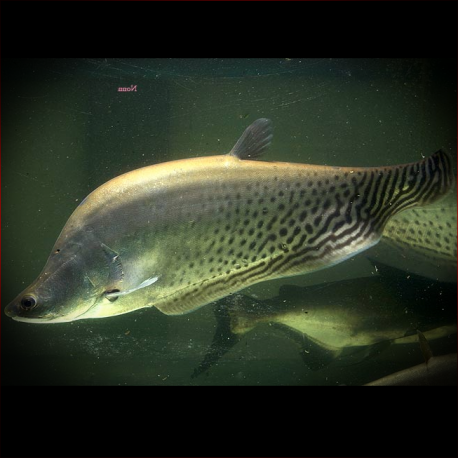More info
Datasheet
| Minimum Tank Size | 10000 litres / 2641.72 US gallons |
| Maximum Size | 120.0cm / 47.24inches |
| Temperature | 20°C / 68.00°F - 28°C / 82.40°F |
| Hardness | 2.02dgH / 36ppm - 15.02dgH / 268ppm |
| pH | 6.0-8.0 |
General Description
The Royal Featherback, also known as the Royal Knifefish, belongs to the category Osteoglossiformes and is classified under the order Osteoglossiformes. It is characterized by its elongated anal fin, continuous with the caudal fin, small scales, and the ability to breathe atmospheric air. This species is distinguishable by numerous small, dark spots on the anterior part of its body that converge to form oblique, irregular stripes extending onto the anal and caudal fins.
Aquarium Setup
The Royal Featherback thrives best in a tank with dim lighting and requires refuges like driftwood, large rocks, or plastic piping for hiding. For optimal care, it is recommended to have a substantial, mature filtration system, regular water changes of 50-70% of the tank volume each week, and well-oxygenated water with some degree of movement. The water parameters should be maintained within a temperature range of 20-28°C, with a pH level of 6.0-8.0, and a hardness of 36-268ppm. The species requires a minimum tank size of 10000 liters.
Behavior
Known to be peaceful with larger fishes that are not considered prey, the Royal Featherback can exhibit territorial behavior towards conspecifics and other similarly-shaped species, particularly when space is limited.
Feeding and Diet
The Royal Featherback is an obligate nocturnal predator that feeds on smaller fish, crustaceans, and other invertebrates in its natural habitat. In captivity, it readily adapts to dead alternatives. Young specimens can be fed chironomid larvae, small earthworms, and chopped prawns, while adults accept fish flesh, whole prawns, mussels, and more. The diet should not include mammalian or avian meat like beef heart or chicken, as these can lead to health issues.
Reproduction & Dimorphism
Reproduction of the Royal Featherback has not been reported in captivity. In their natural habitat, male fish construct nests of branches and leaves, guarding the eggs and fry post-spawning in flooded forest areas during the wet season. There is no reported sexual dimorphism for this species.
Habitat and Distribution
Endemic to the Mekong river drainage in Laos, Thailand, Vietnam, and Cambodia, including regions like the Mekong delta and Tonlé Sap lake system, the Royal Featherback is commonly found in rocky habitats such as deep pools and rapids along the main channel and lower parts of specific tributaries. It is also known to move into flooded forest areas for spawning, though the species faces threats from human activities like dam construction and habitat alterations.

